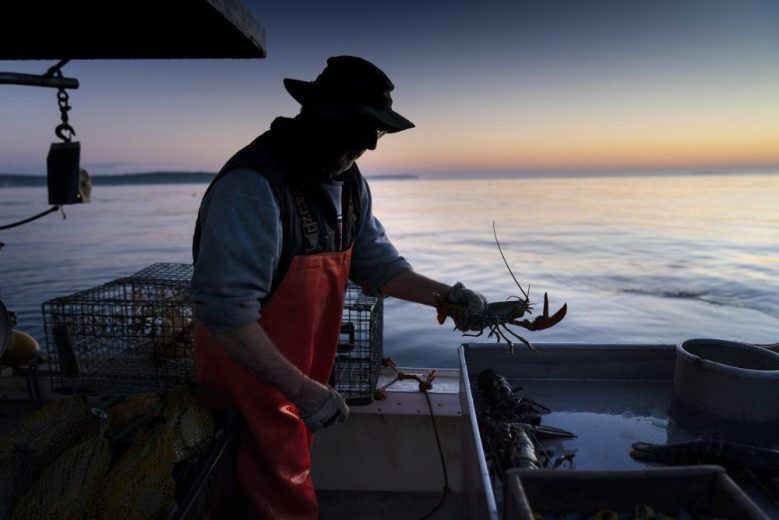A lobsterman moves a lobster to the banding table aboard his boat while fishing off Spruce Head in August 2021. (Robert F. Bukaty/Associated Press)
The population of lobsters off northern New England’s coast is healthy, but it has fallen by more than a third since its peak because of a combination of heavy fishing, a decline in baby lobster food and warming waters, according to fishing regulators.
The Atlantic States Marine Fisheries Commission issued a new lobster population assessment this week that estimated the average lobster population in northern New England at about 201 million in 2023, 34% less than the population’s highpoint in 2018.
The latest estimate is well above the 143 million needed for the stock to sustain itself naturally, scientists say, but below the estimated 229 million needed to sustain the lobster industry at its current levels in changing environmental conditions.
The 583-page report notes that fishermen are catching Gulf of Maine and Georges Bank lobsters faster than the shrinking population can reproduce and replace them.
“Abundance falling below the fishery/industry target does not trigger biological concern that the stock’s ability to replenish itself is jeopardized, but rather that economic conditions of the lobster industry may degrade,” the report warns.
The northern New England lobster fishery includes the Gulf of Maine and Georges Bank stocks. Most Maine lobstermen fish the Gulf of Maine, which accounts for 82% of U.S. lobster landings and is mostly conducted by small day boats. Georges Banks accounts for about 5% of landings.
Maine lobster fetched $528.4 million at the docks last year. That was the smallest haul in 15 years, but the second-highest price-per-pound and the third-highest dockside value in Maine reporting hisotry. Economists value the rest of the supply chain at another $1 billion.
The northern lobster fishery, while not depleted, is now classified as overfished even though New England lobstermen aren’t necessarily fishing harder, fishing more often or seeing their ranks swell, said Caitlin Starks, ASFMC’s lobster management coordinator.
The report doesn’t identify a reason for the population decline, but cites rising sea temperatures – lobsters feel harmful stress above 68 degrees Fahrenheit – and declining numbers of the nutrient-rich plankton favored by baby lobsters as two environmental contributors.
The team that drafted the 2025 stock assessment urged the commission to consider actions that would provide the best chance of stabilizing if not improving the outlook for the northern New England lobster population.
The commission did not approve a formal review, but instead asked staff to come back with details about how long it would take, how much time and money it would cost to do, and whether the staff is able to take on that workload.
Regulators have tried to implement rules to stop lobster population decline but were met with strong opposition. Earlier this year, they enacted rules to increase the mimimum size of lobsters harvested in key fishing areas but repealed them after fishermen said they were unnecessary.
Most Maine lobstermen agree the population is declining and say they have been anticipating this rightsizing for many years, knowing the record-high abundance, landings and favorable ocean conditions couldn’t last forever.
Maine lobstermen are optimistic about the future even as the fishery adapts to changing ocean conditions, said Patrice McCarron, the longtime executive director of the Maine Lobstermen’s Association, the fishery’s biggest trade group.
“As the resource adjusts from record highs, lobstermen remain deeply committed to stewardship, sustainable practices and to protecting the fishery that sustains thousands of Maine families,” she said in response to the assessment.
But McCarron pushed back against the overfishing label. The association has confidence in the science that informs the 2025 lobster stock assessment, but she noted that the modeling found overfishing was occuring in 11 out of 21 runs. The other 10 runs found no overfishing.
“That’s pretty close,” McCarron said. “That’s a very strong label to put on something so close.”
Maine Department of Marine Resources Commissioner Carl Wilson echoed the trade group’s opposition to the overfishing label, which, in a statement to the Maine lobstering community, he dismissed as a technicality that failed to prompt immediate action.
“This fishery is the most valuable in Maine that supports thousands of hard working fishermen and is an economic driver for our coastal communities,” Wilson said. “I’m confident in the commitment of this industry to conservation of this resource.”




